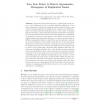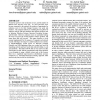511 search results - page 36 / 103 » Organization Detection Using Emergent Computing |
RECOMB
2005
Springer
14 years 8 months ago
2005
Springer
Abstract. Asymmetric functional divergence of paralogues is a key aspect of the traditional model of evolution following duplication. If one gene continues to perform the ancestral...
ACMSE
2005
ACM
14 years 1 months ago
2005
ACM
Accurate identification of misuse is a key factor in determining appropriate ways to protect systems. Modern intrusion detection systems often use alerts from different sources su...
ACMSE
2006
ACM
13 years 9 months ago
2006
ACM
Society has grown to rely on Internet services, and the number of Internet users increases every day. As more and more users become connected to the network, the window of opportu...
CHI
2011
ACM
12 years 11 months ago
2011
ACM
With recent advances in flexible displays, computer displays are no longer restricted to flat, rigid form factors. In this paper, we propose that the physical form of a flexible d...
CVPR
2005
IEEE
14 years 9 months ago
2005
IEEE
This paper addresses the problem of learning and recognizing human activities of daily living (ADL), which is an important research issue in building a pervasive and smart environ...


